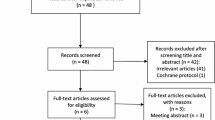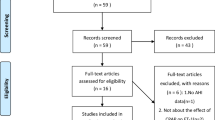Abstract
Purpose
Aldosterone is associated with the development of obstructive sleep apnea (OSA) and cardiovascular diseases. Continuous positive airway pressure (CPAP) is an effective treatment for OSA, but the impact of CPAP therapy on aldosterone levels in patients with OSA remains unclear. To address this issue, a meta-analysis was conducted to evaluate the effects of CPAP therapy on serum aldosterone levels in OSA.
Methods
Two reviewers independently searched PubMed, Cochrane library, Embase, and Web of Science before March 2015. Information on characteristics of subjects, study design, and pre- and post-CPAP treatment of serum aldosterone was extracted for analysis. Standardized mean difference (SMD) was calculated to estimate the treatment effects of CPAP therapy.
Results
A total of 5 studies involving 329 patients were pooled into this meta-analysis, including 3 observational studies and 2 randomized controlled studies. Results indicated significantly decreased aldosterone levels after CPAP therapy (SMD = −0.236, 95 % confidence interval (CI) = −0.45 to −0.02, z = 2.12, p = 0.034).
Conclusions
This meta-analysis suggested that CPAP therapy was associated with a decrease in serum aldosterone in patients with OSA. Further large-scale, well-designed interventional investigations are needed to clarify this issue.




Similar content being viewed by others
References
Parish JM, Somers VK (2004) Obstructive sleep apnea and cardiovascular disease. Mayo Clin Proc 79(8):1036–1046
Lavie P, Herer P, Hoffstein V (2000) Obstructive sleep apnoea syndrome as a risk factor for hypertension: population study. Br Med J 320(7233):479–482. doi:10.1136/bmj.320.7233.479
Grote L, Ploch T, Heitmann J, Knaack L, Penzel T, Peter JH (1999) Sleep-related breathing disorder is an independent risk factor for systemic hypertension. Am J Respir Crit Care Med 160(6):1875–1882
Fletcher EC (2003) Sympathetic over activity in the etiology of hypertension of obstructive sleep apnea. Sleep 26(1):15–19
Somers VK, Dyken ME, Clary MP, Abboud FM (1995) Sympathetic neural mechanisms in obstructive sleep-apnea. J Clin Investig 96(4):1897–1904. doi:10.1172/jci118235
Jelic S, Padeletti M, Kawut SM, Higgins C, Canfield SM, Onat D, Colombo PC, Basner RC, Factor P, LeJemtel TH (2008) Inflammation, oxidative stress, and repair capacity of the vascular endothelium in obstructive sleep apnea. Circulation 117(17):2270–2278. doi:10.1161/circulationaha.107.741512
Dudenbostel T, Calhoun DA (2012) Resistant hypertension, obstructive sleep apnoea and aldosterone. J Hum Hypertens 26(5):281–287. doi:10.1038/jhh.2011.47
Pratt-Ubunama MN, Nishizaka MK, Boedefeld RL, Cofield SS, Harding SM, Calhoun DA (2007) Plasma aldosterone is related to severity of obstructive sleep apnea in subjects with resistant hypertension. Chest 131(2):453–459. doi:10.1378/chest.06-1442
Vasan RS, Evans JC, Larson MG, Wilson PWF, Meigs JB, Rifai N, Benjamin EJ, Levy D (2004) Serum aldosterone and the incidence of hypertension in nonhypertensive persons. N Engl J Med 351(1):33–41. doi:10.1056/NEJMoa033263
Lozano L, Luis Tovar J, Sampol G, Romero O, Jose Jurado M, Segarra A, Espinel E, Rios J, Dolores Untoria M, Lloberes P (2010) Continuous positive airway pressure treatment in sleep apnea patients with resistant hypertension: a randomized, controlled trial. J Hypertens 28(10):2161–2168. doi:10.1097/HJH.0b013e32833b9c63
Martinez-Garcia M-A, Capote F, Campos-Rodriguez F, Lloberes P, Diaz de Atauri MJ, Somoza M, Masa JF, Gonzalez M, Sacristan L, Barbe F, Duran-Cantolla J, Aizpuru F, Manas E, Barreiro B, Mosteiro M, Cebrian JJ, de la Pena M, Garcia-Rio F, Maimo A, Zapater J, Hernandez C, SanMarti NG, Montserrat JM (2013) Effect of CPAP on blood pressure in patients with obstructive sleep apnea and resistant hypertension: the HIPARCO randomized clinical trial. Jama-J Am Med Assoc 310(22):2407–2415. doi:10.1001/jama.2013.281250
Pedrosa RP, Drager LF, de Paula LK, Amaro AC, Bortolotto LA, Lorenzi-Filho G (2013) Effects of OSA treatment on BP in patients with resistant hypertension: a randomized trial. Chest 144(5):1487–1494. doi:10.1378/chest.13-0085
Pepperell JCT, Ramdassingh-Dow S, Crosthwaite N, Mullins R, Jenkinson C, Stradling JR, Davies RJO (2002) Ambulatory blood pressure after therapeutic and subtherapeutic nasal continuous positive airway pressure for obstructive sleep apnoea: a randomised parallel trial. Lancet 359(9302):204–210. doi:10.1016/s0140-6736(02)07445-7
Hozo SP, Djulbegovic B, Hozo I (2005) Estimating the mean and variance from the median, range, and the size of a sample. BMC Med Res Methodol 5:13. doi:10.1186/1471-2288-5-13
Jadad AR, Moore RA, Carroll D, Jenkinson C, Reynolds DJM, Gavaghan DJ, McQuay HJ (1996) Assessing the quality of reports of randomized clinical trials: is blinding necessary? Control Clin Trials 17(1):1–12. doi:10.1016/0197-2456(95)00134-4
Acelajado M, Pisoni R, Calhoun DA (2010) Treatment of obstructive sleep apnea with continuous positive airway pressure (CPAP) does not reduce aldosterone levels in hypertensive patients. J Investig Med 58(2):426
Tamisier R, Lacedonia D, Monneret D, Baguet JP, Levy P, Jean-Louis Pepin JL (2010) Effects of CPAP and valsartan randomly assigned on baroreflex function and aldosterone in hypertensive OSAS [abstract]. European Respiratory Society Annual Congress, Barcelona, Spain, September 18–22:[1663]
Akashiba T, Otsuka K, Yoshizawa T, Kurashina K, Kawamura T, Sasaki I, Hosokawa Y, Horie T (1991) Effects of nasal continuous positive airway pressure (NCPAP) on nocturnal renal function in obstructive sleep apnea syndrome (OSAS). Nihon Kyobu Shikkan Gakkai Zasshi 29(5):573–577
Follenius M, Krieger J, Krauth MO, Sforza F, Brandenberger G (1991) Obstructive sleep apnea treatment: peripheral and central effects on plasma renin activity and aldosterone. Sleep 14(3):211–217
Svatikova A, Olson LJ, Wolk R, Phillips BG, Adachi T, Schwartz GL, Somers VK (2009) Obstructive sleep apnea and aldosterone. Sleep 32(12):1589–1592
Zhang XL, Li YQ (2009) Efficacy of continuous positive airway pressure therapy upon resistant hypertension in patients with obstructive sleep apnea hypopnea syndrome. Zhonghua yi xue za zhi 89(26):1811–1814
Xiao Y, Yin K, Zheng P (2000) Significance of the changes of urinary uric acid, ANP, renin and aldosterone in sleep apnea syndrome patients. Zhonghua jie he he hu xi za zhi = Zhonghua jiehe he huxi zazhi = Chin J Tuberc Respir Dis 23(1):27–30
Saarelainen S, Hasan J, Siitonen S, Seppala E (1996) Effect of nasal CPAP treatment on plasma volume, aldosterone and 24-h blood pressure in obstructive sleep apnoea. J Sleep Res 5(3):181–185
Meston N, Davies RJO, Mullins R, Jenkinson C, Wass JAH, Stradling JR (2003) Endocrine effects of nasal continuous positive airway pressure in male patients with obstructive sleep apnoea. J Intern Med 254(5):447–454. doi:10.1046/j.1365-2796.2003.01212.x
Moller DS, Lind P, Strunge B, Pedersen EB (2003) Abnormal vasoactive hormones and 24-hour blood pressure in obstructive sleep apnea. Am J Hypertens 16(4):274–280
Barcelo A, Pierola J, Esquinas C, de la Pena M, Arque M, Alonso-Fernandez A, Bauca JM, Robles J, Barcelo B, Barbe F (2014) Relationship between aldosterone and the metabolic syndrome in patients with obstructive sleep apnea hypopnea syndrome: effect of continuous positive airway pressure treatment. PLoS One 9(1):e84362. doi:10.1371/journal.pone.0084362
Lloberes P, Sampol G, Espinel E, Segarra A, Ramon MA, Romero O (2014) A randomized controlled study of cpap effect on plasma aldosterone concentration in patients with resistant hypertension and obstructive sleep apnea. J Hypertens 32(8):1650–1657
Connell JMC, Davies E (2005) The new biology of aldosterone. J Endocrinol 186(1):1–20. doi:10.1677/joe.1.06017
Williams JS, Williams GH (2003) 50th anniversary of aldosterone. J Clin Endocrinol Metab 88(6):2364–2372. doi:10.1210/jc.2003-030490
Pimenta E, Calhoun DA, Oparil S (2009) Sleep apnea, aldosterone, and resistant hypertension. Prog Cardiovasc Dis 51(5):371–380. doi:10.1016/j.pcad.2008.02.004
Goodfriend TL (2008) Obesity, sleep apnea, aldosterone, and hypertension. Curr Hypertens Rep 10(3):222–226. doi:10.1007/s11906-008-0042-x
Patel SR, White DP, Malhotra A, Stanchina ML, Ayas NT (2003) Continuous positive airway pressure therapy for treating sleepiness in a diverse population with obstructive sleep apnea—results of a meta-analysis. Arch Intern Med 163(5):565–571. doi:10.1001/archinte.163.5.565
Acknowledgment
This work was supported by grant 2013-2-88 for Youth Research Fund from Fujian Province Health Bureau.
Author information
Authors and Affiliations
Corresponding author
Ethics declarations
Compliance with ethical standards
The manuscript does not contain any studies with human participants or animals performed by any of the authors.
Conflict of interest
The authors declare that they have no competing interests.
Rights and permissions
About this article
Cite this article
Yang, Sj., Jiang, XT., Zhang, XB. et al. Does continuous positive airway pressure reduce aldosterone levels in patients with obstructive sleep apnea?. Sleep Breath 20, 921–928 (2016). https://doi.org/10.1007/s11325-015-1311-y
Received:
Revised:
Accepted:
Published:
Issue Date:
DOI: https://doi.org/10.1007/s11325-015-1311-y




